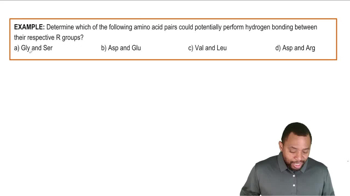What amino acids do the following abbreviations stand for? Draw the structure of each.
a. Val
 Verified step by step guidance
Verified step by step guidance Verified video answer for a similar problem:
Verified video answer for a similar problem:



 3:14m
3:14mMaster Phonetic 1-Letter Amino Acid Codes Concept 1 with a bite sized video explanation from Jules
Start learning